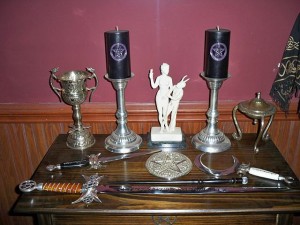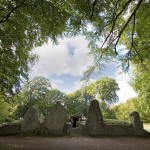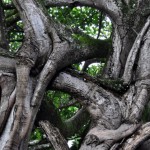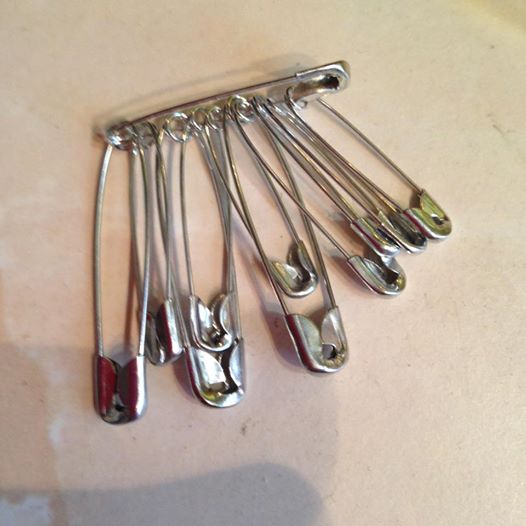The other day, I saw a meme which said that you don’t need magical tools, initiation, or a Book of Shadows to be a Wiccan. Well, maybe you don’t need these things, but they are what people think of when they think of Wicca. They are among the things that get you recognised as being part of the Wiccan community, because they are symbols and experiences and ideas that we all share. They are also useful. You don’t need a knife and fork to eat your dinner, but it makes it a lot easier. You don’t need an address book to write your friends’ addresses in – but it makes it a lot easier to remember where they live and post them Yule cards. And you don’t need a rite of passage to help you feel like an adult – but it makes it easier if a definite transition has been marked.
I would like there to be as broad an interpretation of the term “Wiccan” as possible, and an even broader interpretation of the term “witch”, because that is how they were originally intended to be used (the term Wiccan was not coined exclusively for the use of Gardnerian Wiccans, or even Alexandrian plus Gardnerian – it was intended to refer to all witches, as Ethan Doyle White has shown from his historical research). I am okay with people identifying as Wiccan without initiation – but if you want to be part of the initiatory Wiccan community, or another initiatory community such as Feri, then you need initiation. Initiation is a powerful transformational ritual.
The purpose of a Book of Shadows is not to prescribe how you should do your rituals, but to record powerful rituals that you have done, and to transmit powerful rituals written by past Wiccans. Each witch’s book should be unique to them, although it will also contain the rituals that have been passed down to them. A Book of Shadows is a magical tool for recording and transmitting good rituals.
What about tools such as wands, athames, swords, chalices, and so on? There are several reasons why they are helpful. I do think that a good witch should be able to do a spell or ritual without any tools in an emergency – but I still use tools when they are available.

Humans are tool-using animals. One of the things that helps us to think and solve problems is our tool-using propensities. Look at other animals who use tools. We tend to think they are cleverer than animals who don’t use tools, because they can manipulate more of their environment.
According to Tool Use in Animals: Cognition and Ecology:
The last decade has witnessed remarkable discoveries and advances in our understanding of the tool using behaviour of animals. Wild populations of capuchin monkeys have been observed to crack open nuts with stone tools, similar to the skills of chimpanzees and humans. Corvids have been observed to use and make tools that rival in complexity the behaviours exhibited by the great apes. Excavations of the nut cracking sites of chimpanzees have been dated to around 4-5 thousand years ago.
Think about how we use physical tools such as screwdrivers, hammers, brooms, milk-frothers, egg-stiffeners, paint-stirrers, and so on, and how difficult life would be without those tools. Think about how chimpanzees have been seen getting ants out of ant-hills with a straw, or cracking nuts open with a rock. Frequently, tool use involves remembering that you saw a useful-looking rock, or a hollow blade of grass, going to fetch it, and bringing it to where the food is. So tool use involves the use of cognitive skills such as memory, comparison, and visualisation.
My partner Bob pointed out that it is much is easier to do a task (magical or mundane) without a tool when you have learnt to do it with a tool.
Tools are levers for affecting the world. You can’t tighten a screw without a screwdriver. You need a wooden spoon to stir a pan of soup or stew, otherwise you would burn your fingers. You can cast a magical circle without a sword or a wand – but it feels like a better and more magical circle when it has been cast with the appropriate tool. The subtle energies involved in magic are affected by physical tools in much the same way as denser matter is affected by tools.
Magic is not all in the mind – the body is part of it too. The people who claim you don’t need tools also tend to claim that doing magic is a purely mental process. The conceptual separation of mind and body, spirit and matter, is a Western phenomenon which has been a disaster for our civilisation in so many ways, involving the denigration of sexuality and sensuality, the denial of the pleasures of the flesh, a dysfunctional relationship with food, and behaving as if the Earth, the other animals, birds, and plants with whom we share it are expendable. Using magical tools helps to remind us that magic is an embodied spirituality, and to involve our bodies in the process of creating magical energy. Indeed, some of the tools used in Wicca have specific uses for enhancing the sense of being in the body.
Tools are powerful symbols. Much of magic and ritual is about engaging with and awakening the poetic and symbolic aspects of the mind (the “right-brain” functions). The use of tools as symbols speaks to these aspects of the mind (sometimes referred to as “Younger Self”). Tools are part of a complex set of magical associations involving directions, elements, planets, deities, trees, and so on, all of which speak to the poetic, mystical, and symbolic side of our natures. They are part of a poetic language of witchcraft. The process of getting into the twilight consciousness required for ritual is assisted and enhanced by the use of familiar words, tools, imagery, and physical movements, evoking muscle memory and awareness of space.
So, maybe you don’t need tools, but why would you want to do without them?
















